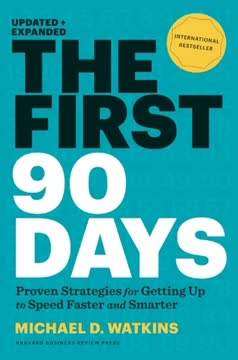Key Takeaways
1. Clarity is the essence of great leadership
Great leaders rally people to a better future.
Clarity conquers anxiety. Leaders must provide clear answers to four critical questions: Who do we serve? What is our core strength? What is our core score? What actions can we take today? By offering clarity on these points, leaders transform their followers' anxiety about the unknown future into confidence. This clarity enables resilience, persistence, and creativity among team members.
Effective communication is key. Great leaders excel at distilling complex ideas into simple, vivid descriptions that resonate with their audience. They practice and refine their messages, seeking out new and larger audiences to share their vision. Leaders should not worry about repetition; the moment they start to feel bored with their own message might be when it finally starts to penetrate and inspire their followers.
2. Successful managers capitalize on individual uniqueness
Discover what is unique about each person and capitalize on it.
Strengths-based management. Great managers recognize that each employee has a unique set of talents, motivations, and learning styles. Instead of trying to mold everyone into a predetermined ideal, they focus on identifying and leveraging each person's strengths. This approach leads to higher engagement, productivity, and job satisfaction.
Tailored approach to development. Effective managers:
- Identify each employee's strengths and weaknesses
- Understand their individual triggers and motivations
- Recognize their unique learning style
By tailoring their management style to each individual, they create an environment where employees can thrive and contribute their best work.
3. Identify your core customer to drive organizational success
Find the most generous explanation for each other's behavior and believe it.
Customer focus drives success. Successful organizations clearly define who they serve and orient their entire operation around meeting that customer's needs. This clarity of purpose helps align all departments and employees towards a common goal, leading to better decision-making and resource allocation.
Examples of customer-centric strategies:
- Tesco focusing on serving the working man and woman
- Wal-Mart targeting customers who live paycheck to paycheck
- Best Buy tailoring each store to serve a specific customer segment
By clearly defining their core customer, these companies were able to differentiate themselves in the market and achieve sustained success.
4. Leverage your organization's core strength for competitive advantage
If you dig into a subject deeply enough, what do you find?
Identify and cultivate your unique strength. Every organization has a core strength that sets it apart from competitors. Successful leaders identify this strength and build their entire strategy around leveraging it. This focus allows the organization to create a sustainable competitive advantage.
Examples of leveraging core strengths:
- Toyota focusing on reliability
- Walgreens emphasizing convenience
- Apple excelling at user-friendly technology
By clearly communicating and consistently reinforcing their core strength, leaders can align their entire organization towards maximizing their competitive advantage.
5. Focus on one key metric to measure progress
I'll tell you the secret to life. This one thing. Just this one thing. You stick to that and everything else don't mean s**t.
Choose a single, impactful metric. While organizations generate numerous performance indicators, great leaders identify one core metric that best captures progress towards their vision. This singular focus helps align efforts, simplify decision-making, and drive consistent improvement.
Examples of core metrics:
- Crime statistics for New York City under Rudy Giuliani
- Number of engaged employees at Best Buy
- Number of lost-time injuries at Rio Tinto Borax
By rallying their organization around a single, clear metric, leaders can create a shared sense of purpose and drive sustained performance improvement.
6. Use symbolic and systematic actions to clarify your vision
If you sit down with your boss and your boss hasn't said something to you about your weaknesses, go back! Because otherwise you are not going to learn anything.
Actions speak louder than words. Great leaders use a combination of symbolic and systematic actions to reinforce their vision and priorities. Symbolic actions grab attention and create memorable moments that illustrate the leader's commitment. Systematic actions change routines and processes, ensuring that the vision is embedded in daily operations.
Examples of leadership actions:
- Symbolic: Rudy Giuliani removing squeegee men from New York City streets
- Systematic: Giuliani implementing CompStat meetings to track crime statistics
- Symbolic: Preston Chiaro employing a turtle handler at Rio Tinto Borax
- Systematic: Chiaro implementing personal safety improvement plans for all employees
By combining both types of actions, leaders can create a powerful and lasting impact on their organization's culture and performance.
7. Discover what you don't like doing and stop doing it for sustained success
You are never as strong as when you have clearly in mind your successes.
Focus on your strengths. Sustained individual success comes from identifying your natural talents and consistently applying them in your work. However, as you progress in your career, new responsibilities can pull you away from your strengths. To maintain long-term success and fulfillment, you must be vigilant about identifying and eliminating activities that don't align with your strengths.
Keys to sustained success:
- Identify your natural talents and strengths
- Seek out roles and responsibilities that leverage these strengths
- Regularly assess your activities and eliminate those that drain your energy
- Be willing to say no to opportunities that don't align with your strengths
- Continuously refine and develop your areas of strength
By consistently focusing on what you do best and enjoy most, you can achieve sustained success and fulfillment in your career.
Last updated:
FAQ
What's The One Thing You Need to Know About Great Managing, Great Leading, and Sustained Individual Success about?
- Core Insights Focus: The book emphasizes identifying the single most crucial insight in managing, leading, and achieving personal success. Losing sight of this "one thing" can diminish even the best efforts.
- Roles Distinction: It distinguishes between managing and leading, explaining that each role requires different skills and approaches. Managers focus on individual strengths, while leaders rally people towards a shared vision.
- Practical Applications: Provides practical advice and frameworks for applying these insights in real-world scenarios, making it valuable for both aspiring and seasoned leaders.
Why should I read The One Thing You Need to Know?
- Expert Insights: Written by Marcus Buckingham, a respected authority on management and leadership, offering well-researched insights based on extensive interviews and studies.
- Actionable Strategies: Filled with actionable strategies that can be implemented immediately to improve management and leadership effectiveness.
- Focus on Individualization: Emphasizes understanding and capitalizing on the unique strengths of individuals, leading to better team dynamics and overall success.
What are the key takeaways of The One Thing You Need to Know?
- Great Managers Play Chess: Effective managers understand the unique strengths of each employee and tailor their management approach accordingly.
- Extended Empathy in Leadership: Great leaders connect with universal human emotions and fears to inspire and rally their teams.
- Four Basic Skills of Management: Selecting good people, defining clear expectations, recognizing excellence, and showing care for employees are essential skills.
What is the difference between managing and leading according to The One Thing You Need to Know?
- Distinct Roles: Managing involves overseeing tasks and ensuring employees meet specific expectations, while leading is about inspiring and motivating people towards a shared vision.
- Focus on Individuals vs. Vision: Managers focus on individual strengths and weaknesses, while leaders concentrate on the broader picture and rallying people towards a better future.
- Complementary Functions: Both roles are essential for organizational success, requiring strong management and visionary leadership to thrive.
How can I identify the "one thing" I need to know about managing or leading?
- Self-Reflection: Reflect on experiences and identify what consistently drives success in your management or leadership roles.
- Feedback from Others: Seek feedback from colleagues and team members about the most important aspect of your management or leadership style.
- Continuous Learning: Engage in ongoing learning and development to refine your understanding of effective management and leadership.
What are the four basic skills of good management outlined in The One Thing You Need to Know?
- Selecting Good People: Hire individuals who possess the right talents for the roles, involving careful consideration and understanding of each position's requirements.
- Defining Clear Expectations: Communicate clear expectations to employees to avoid confusion and ensure alignment with goals.
- Recognizing Excellence and Praising It: Acknowledge and celebrate employees' achievements to motivate and boost morale.
- Showing Care for Employees: Demonstrate genuine care for employees' well-being and success, fostering a positive work environment.
How do great managers capitalize on individual strengths?
- Understanding Unique Talents: Take time to understand the unique strengths and weaknesses of each employee through observation and conversation.
- Tailoring Roles and Responsibilities: Align roles and responsibilities with identified strengths to enhance engagement and performance.
- Providing Opportunities for Growth: Create opportunities for employees to develop their strengths further through challenging projects.
What is the significance of extended empathy in leadership?
- Connecting with Shared Emotions: Allows leaders to connect with universal emotions and fears, fostering trust and loyalty among team members.
- Inspiring Action: Understanding and articulating shared fears and needs can inspire action towards a common goal.
- Building Stronger Relationships: Practicing extended empathy builds stronger relationships, leading to a cohesive and motivated workforce.
What does Marcus Buckingham mean by "intentional imbalance"?
- Emphasizing Uniqueness: Magnifying and capitalizing on unique strengths rather than fitting everyone into a standard mold.
- Clarity Over Complexity: Focus on clear, specific goals and unique contributions rather than balancing all aspects equally.
- Driving Performance: Leads to higher performance and satisfaction by allowing individuals to thrive in their areas of strength.
How does The One Thing You Need to Know define sustained individual success?
- Greatest Impact Over Time: Making the greatest possible impact over the longest period, regardless of the field.
- Strengths and Learning: Leverage strengths and continuously learn to adapt and grow in a changing environment.
- Avoiding Weaknesses: Focus on strengths rather than fixing weaknesses, eliminating activities that drain energy.
What are the main emotions that cause discontent in work, according to The One Thing You Need to Know?
- Boredom: Leads to disengagement and a lack of motivation when work is uninteresting.
- Unfulfillment: Misalignment between personal values and job responsibilities creates frustration and dissatisfaction.
- Frustration: Engaging in tasks that do not utilize strengths can lead to feelings of being drained and ineffective.
What are the best quotes from The One Thing You Need to Know and what do they mean?
- "Get me to the core.": Emphasizes the need for clarity and simplicity in understanding complex subjects.
- "Great managers play chess.": Highlights the necessity for managers to recognize and leverage unique employee strengths.
- "Discover what is unique about each person and capitalize on it.": Encourages a personalized management approach to foster engagement and performance.
Review Summary
The One Thing You Need to Know receives mostly positive reviews for its insights on management, leadership, and personal success. Readers appreciate Buckingham's research-backed approach and practical advice, though some find the title misleading as it covers multiple concepts. The book is praised for its engaging style and valuable tips, particularly for new leaders. Critics note repetition and a lack of citations. Overall, it's considered a solid read for those seeking to improve their leadership skills and leverage personal strengths.
Similar Books










Download PDF
Download EPUB
.epub digital book format is ideal for reading ebooks on phones, tablets, and e-readers.










